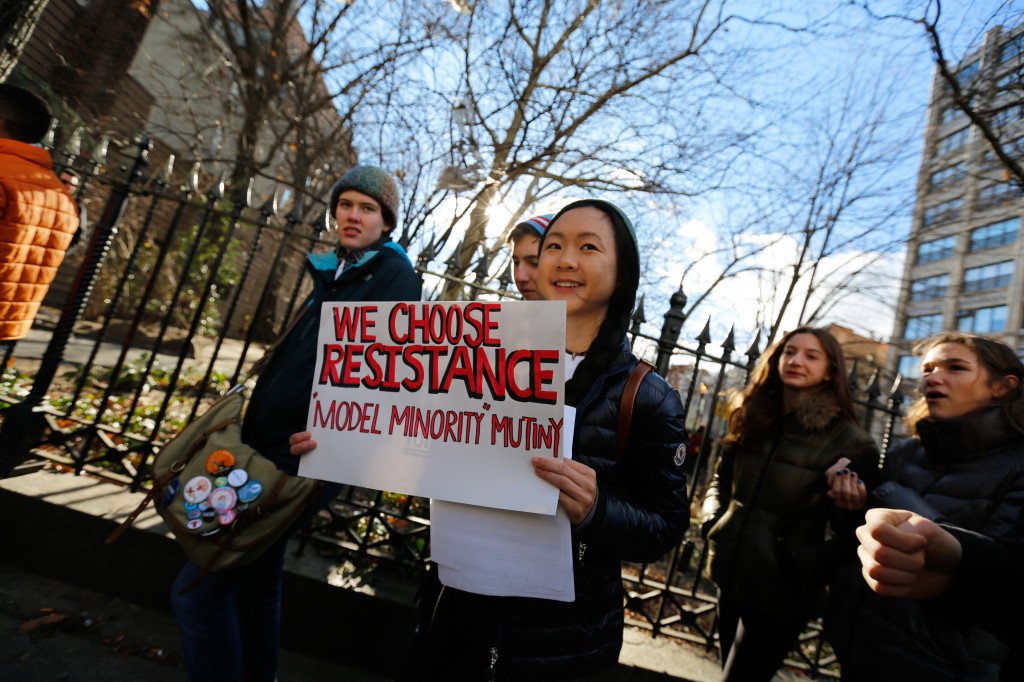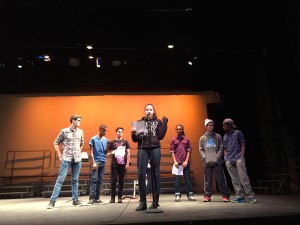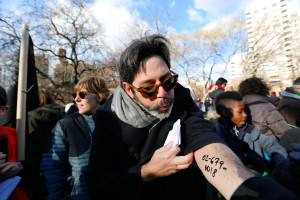
Photo by Lucas Philips
Two non-indictment verdicts — in the cases of Michael Brown and Eric Garner — have sparked protests across the Fieldston campus, where students and teachers are expressing their outrage through various forms of activism.
On November 24, a St. Louis County grand jury decided not to indict white police officer Darren Wilson, 28, who shot and killed black 18-year-old Michael Brown. The decision led to widespread protesting and violence in Missouri and throughout the country.
Eight days after the Brown decision, a Staten Island grand jury declined to indict a white police officer — Daniel Pantaleo, 29 — after he was caught on video fatally choking a black man — Eric Garner, 43.
On Saturday, many ECF community members — including Damian Fernandez, Laura Danforth, Nancy Banks, and Rob Cousins — attended the Millions March, a protest organizers say demands justice “for all those killed by racist killer cops.”
The march drew more than 50,000 protesters to the streets, according to Millions March organizers. The NYPD said there were about half that number.

Photo by Lucas Philips
“After hearing the verdict on Darren Wilson and not coming to terms with the fact that there would be no indictment,” said Cid Nichols, an organizer of the Millions March, “I had enough of sitting around wondering how I could help. So I started the event on Facebook and I invited the maximum amount of friends that Facebook allowed. I’m really glad I did now, because its just taken off on its own.”
Police presence at the march was scarce. Officers stood on the side, mostly silent, refusing to comment when prompted with questions by the media. But one detective consented to a brief interview.
Detective Stephen Cavendish has served in the NYPD for 19 years, currently working on the Detective Squad at the 61st Precinct.
“I think people are entitled to their opinion,” Cavendish said, “if they think changes need to be made, democracy in this country allows you to go out and voice your opinion.”
For the most part protesters are pretty well behaved, but not everyone is peaceful or polite, Cavendish said.
“If somebody attempts to confront you,” he said, “you just have to be strong and let them voice their opinion. It bothers me because I go out and I put my life on the line everyday. Part of me is offended by it; part of me understands it.”
Detective Cavendish said the Millions March was one of the biggest protests he has seen in his 19 year tenure at the NYPD.
In the upper school, students have responded to the news with protests, teach-ins, walk outs, and much discussion.
On November 25, students — dressed in black clothing and covered in writing — gathered on the quad during lunch to take a picture in support of Brown.
“It’s all just really draining,” said Dejon Bunn-Constant (VI), “but nothing that’s extremely historically significant has ever just been done with 100 percent grace and no flack at all. It’s exhausting work, but it’s worth it. I’m ready to continue putting my whole self into it.”
The following Monday, December 1, students walked out of class, chanting “hands up, don’t shoot.” The action was part of a nationwide “Hands Up Walk Out” movement. Once gathered on the quad, over 100 students lowered their heads in a four and a half minute moment of silence, symbolic of the roughly four and a half hours Brown’s body lay on a Ferguson street.
In the middle school, students have also taken the initiative into their own hands.
On December 5, a group of eighth graders posted print-outs of the American flag with the now popular slogan, “#BlackLivesMatter,” across the school. The same day, another group of students modified the signs to read “#AllLivesMatter,” leaving some frustrated and confused by the response.
“I think saying ‘all lives matter’ takes away from the issue,” said Kenja-Rae Farquharson (VI), who has been involved in student activism. “We know all lives matter; that’s a fact. The problem is that black lives are being treated as if they’re not worth as much.”

Photo by David Fishman
After the print-out incident, on Monday, middle school students walked out of class and marched around campus bearing signs in support of Brown and Garner. The students made their way across the quad, and through the upper school hallways.
“I didn’t think it was going to be as big a turn out,” said Nai’im Hurdle-Price (Grade 8), who helped organize and lead the march. “The day before people were saying the walkout was going to be stupid and dumb. It was an amazing turnout, almost everyone in our grade came out.”
Three days later, on December 11, the middle school participated in a “teach-in,” with workshops geared at further stimulating education and discussion. Some of the workshops included: “Just the Facts, Please, White Allyship, Methods of Protest, Social Media, The Justice System, and Talking About Race.”
As protests and demonstrations increase in frequency and passion at Fieldston, not everyone has been on board with their message.
“My opinion on the whole matter is that what happened in the Garner case was just wrong,” said Ben Gottschalk (VI). “In the Ferguson case, I believe that Michael Brown was at fault, especially after the autopsy proved that he was shot in the front and that he reached for Darren Wilson’s gun. Both of these cases shine a light on the flawed judicial system. However, I believe that both of the cases have very little or even nothing to do with race, proven by the Dillon Taylor case. There are a ton of damn good police officers out there who keep the public safe. Just because a few of their peers made mistakes does not mean that every single police officer is racist and brutal.”
Josh Kauderer (VI) also agreed that the focus was misplaced in recent rallying, particularly around certain slogans.
“Like others,” Kauderer said, “I was deeply disturbed by the Eric Garner video and believe that it is important to question a judicial system that resulted in no indictment. I am concerned, however, that in their zeal to question, some have lost sight of the apparent facts, particularly in the Brown case. An example of this is obvious in the ‘Hands Up, Don’t Shoot’ mantra. I think it is misleading and incredibly dangerous to adopt a gesture predicated on unsupported facts.”
Many other students, when prompted for a quote, refused to comment, fearing a negative response from the community.
For her part, Upper School principal Laura Danforth is ready to continue the fight, but is mindful that some students may not feel safe speaking out.

Photo by David Fishman
“My number one goal is the emotional and physical safety of the students,” Danforth said. “If one student can’t bring all of who they are — their political views, their sexuality, their socioeconomic background, their family origin and where they come from, how smart they are — then we have work to do.”
While students have been vocal about the issues at hand, the Administration has kept quiet until recently.
On December 9, Head of School Damian Fernandez sent out an email to parents, later forwarded to students, expressing his support for protesting and outlining the school’s plan to provide “safe spaces where all of the members of [the] community can come together to discuss and process the difficult but important issues.”
But some students were upset and angered by the Administration’s delayed response and lack of recognition.
“I think more awareness should be raised,” said Victoria Smith (V). “All the protests that are going on, all the buzz that’s going around is from student activists. I think their work needs to be more supported and recognized by the Administration.”
Others felt that the issue was more complicated than what first meets the eye.
“An official Fieldston response, such as a protest, is a tricky subject,” said co-FSG president Jake May (VI). “Fieldston as an institution can be incredibly influential. But, while a protest could be powerful, at the same time, I think it could make students who aren’t into protesting feel alienated, or obligated to do something they aren’t comfortable doing.”
A few teachers and faculty members in the ECF community preempted normal classes last week in an effort to further educate their students about the issues.
“There are times that call to interrupt my programming and ask, what’s most important?” said English teacher Kate Reynolds. “What will students remember and need after they graduate? I spent more than two full days examining the cases, including how Darren Wilson’s testimony — his grammar, figurative language, passive construction and ambiguous pronouns — contributed to his construction of innocence and the criminalization of Michael Brown.”
History teacher Mr. Cullen also opened up his Humanities section to discussion about the racial issues in connection to Frederick Douglass’s slave narrative.

Photo by Lucas Philips
Five other faculty members wrote a statement on behalf of their colleagues, read aloud by co-writer Dr. Alwin Jones to the school on Thursday, December 11.
“At this critical juncture in our nation’s history,” Dr. Jones said, “we feel it is incumbent upon us as an institution… to actively and publicly weigh in on the tragic events that have taken place. There is a time when remaining silent makes as distinct a statement as speaking, and this is an occasion when, as citizens and as educators, remaining silent is not a viable option. We want the ECFS banner to stand high and be counted.”
In the lower school, principal George Burns is teaching his students about the issues, prompted by an 8th grade demonstration outside of the building.
“The first thing we want to do is find out what the kids know already,” Burns said. “We do a lot of listening. More recently — as this has become a much larger presence — we’re planning more direct discussions. What happens when police don’t do what they’re supposed to do? How can we deal with situations when people are being targeted? But there’s only a certain level you can get into that with a 7-year-old.”
One strategy set to be employed in the lower school and at Ethical Culture is affinity groups. Beginning in February, students will be divided up into discussion sections based on their race.
“I think there’s concern from the community about being careful how we implement this,” said Rob Cousins, principal at Ethical Culture. “Basically we’ll ask parents to select an affinity group for their child, or they can choose not to have an affinity group, and just have a general conversation. That was important to parents, because for some that’s a very tricky thing. It’s not a comfortable conversation for a lot of adults.”
The ECF community has responded to affinity groups with some reservations.
“It’s been a real learning process for us to understand what that means for us as a white family” said parent Becky Tolson, who has a son in Form III and a daughter in 5th grade. “I’m very much in support of it. I think the only thing is that it’s an incredibly complicated endeavour and I feel like it’s being rolled out rather quickly.”
Outside of Fieldston, students are partaking in daily protests throughout New York City, where the demonstrations have taken on a more violent form.

Photo by Lucas Philips
On Monday, December 1, students left school at 11:30 am and joined a growing group of protesters at Union Square. Later that day, senior Adam Ettelbrick was arrested while marching down 3rd Avenue.
“While the photographs and story behind my arrest were certainly dramatic,” Ettelbrick said, “it is also important to know that there are young men and women of color who have to fear arrest every single day not for leading a protest and disobeying police orders, but for walking down the street. To students who have not yet been out there: start fighting. To students who have been out there: keep fighting. You are the ones changing the world.”
The ECF community remains largely enraged by the non-indictment verdicts.
“It is a historical moment in the United States post civil rights,” Dr. Fernandez said. “We need to do better as a country. I think our community is clearly behind the sense of human rights and the struggle for justice, both in spirit and in action.”









